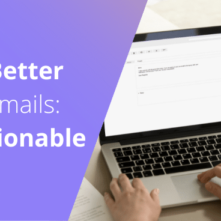Have you ever written a bland sales email that made you think: If I was the prospect, I’d delete this in a heartbeat?
Don’t lie. Because we’ve all done that.
Let’s face it: writing a sales email is HARD. In less than 100 words, you’ve got to do multiple things:
- Hook: Get the reader’s attention
- Add Value: Communicate your value prop clearly and concisely
- Rapport: Build trust with the prospect
- Drive to the Next Step: Convince the reader to follow your CTA
And worse: if you come across as trying too hard or being too sales-y, then you’ll end up in the trash.
Even if your organization has a solid sales process and your reps are great on the phone, sending an email to support your sales calls is an essential part of prospecting. So let’s walk through some tips to write better sales emails—and some templates that can get you started.
READ: Sales Outreach: How to Incorporate Emails and Phone Calls Into Your Sequences
What is the point of sales emails?
Before we dive into some stats, tactics, and strategies, let’s get one thing straight: sales outreach is simply a means to an end.
The end: getting the prospect to either hop on a call, or tell you they’re not interested.
If you aren’t achieving one of those two things, then you’re likely experiencing one of the following problems:
- You’re not targeting the right prospects
- You’re not capturing the prospect’s attention (either in the subject line or email opening)
- The prospect doesn’t trust you
- You’re not making your value prop clear
- There are no clear next steps for them to take
Here’s the thing: 72% of business professionals prefer email communication for back-and-forth interactions. So rather than write off email as a dead art form, let’s see about making those emails better and more effective.
Who should write sales emails: sales or marketing?
And this is where we get into an age-old debate: who should write sales emails? Sales or Marketing?
A lot of organizations prefer the marketing team to take care of this. But the main reason for this is that a lot of salespeople are bad at writing emails. Either because they aren’t gifted writers, or because they get so focused on a singular goal (e.g. pitching) that they come off as too aggressive or tunnel-visioned.
But although marketers typically have more experience writing emails, that doesn’t mean they can necessarily write one-to-one communications. Here are some of the reasons:
- Marketers struggle to write in the salesperson’s voice
- Marketing emails tend to lack one-to-one personalization and connection
- Marketers aren’t researching the individual prospects, so they don’t know how to tailor their message to the audience
So while salespeople should write their own emails, it’s a good idea to seek out advice from Marketing on how to do it well. Plus, this is a great way to generate more marketing-sales alignment.
Here are some ways your marketing team can help salespeople write better email outreach.
Buyer Personas & Prospect Psychology
A key part of any marketing strategy is creating buyer personas to better understand your target customer. These resources can help salespeople better understand how prospects think and tailor their message accordingly.
Data & Insights From Marketing Campaigns
Marketing campaigns create data. Sometimes this data shows that a campaign has worked well. Sometimes it shows that it’s flopped. Either way, this can be helpful in understanding which creative, copy, and other elements have been effective at drawing in your target buyer.
Key Messaging & Value Prop Statements
Remember how I said earlier that a sales email should clearly state your value prop?
Guess who’s spent months, perhaps years, researching and refining the best way to communicate that value? That’s right: the marketing team.
If something in your email isn’t hitting the right pain points, your marketing team can help you figure it out. Plus, if you’re wondering “what do I even say?” in your emails, there’s no need to reinvent the wheel.
Automation Expertise
Like it or not, your marketing team has (or should have) a ton of experience marketing key communications and messages. They know the pitfalls of batch sending a thousand emails a day (don’t do this) and how to avoid getting your email account suspended.
Don’t hesitate to rely on them for key insights and to help get started, especially if automation tools are new to you or your team.
Avoiding Tunnel Vision
Here’s the thing: salespeople can be aggressive. All we care about is selling product and getting people on calls, which is great.
But that often means that we have tunnel vision: we go into sales emails just focused on talking up the product and pushing people to get on a call. For prospects who’ve just heard about the company for the first time, this can be a bit concerning.
Having the marketing team (or anyone, really) look over the email can help you avoid some common pitfalls:
- Are you talking about the value, or features and functionality?
- Are you making your company the center of the email, or the prospect?
- Are you talking about what the prospect needs/wants, or what you want them to need/want?
Remember to keep your messaging SWIIFT℠. New to SWIIFT℠? Check it out here.
Getting an outside perspective can help you break out of the tunnel vision and craft a message that’s more likely to convert.
12 Actionable Tips to Craft Better Sales Emails
So although Marketing can help you improve your sales emails, you still have to sit down and write the darn things yourself. Here are 12 actionable tips that you can implement fairly easily, and will take your emails to the next level.
1. Target the Right Leads
This is the most important, but most people skip over it. Before you sit down to write an email, know exactly who you’re targeting, and make sure they’re actually a good fit. Otherwise, your stellar emails will fall on deaf ears.
2. Don’t Just “Set It and Forget It”
Automation enables salespeople to do outreach at scale. However, that doesn’t mean you should “set it and forget it.” Make sure you’re constantly reviewing your data, and making adjustments based on prospect responses (or lack thereof).
3. Keep Your Sales Emails Short and Sweet
Great sales emails are shorter than you probably think. Stick to 100 words or less (125 max). That seems daunting, but people aren’t going to read much more than that. So you may as well pack all your key info into that space!
4. Personalize Your Emails
Don’t just copy and paste and change the first name. Research the buyer and try to understand their situation and how you can help them do their job better. There’s no turn-off like a lazy salesperson!
5. Make Your Value Prop Clear
Always picture your prospect asking the question: why shouldn’t I delete this email? Because, let’s face it, that’s the default setting. Make the value you offer them crystal clear. Better yet, write in a way that makes it irresistible.
WATCH: Fast And Easy Ways To Speak Value With Your Prospects
6. Reference Your Competitors
This may seem counterintuitive, but remember that buyers today are more informed than ever. They know who your competitors are. So you may as well own the conversation and clearly state why you’re better than them.
7. Write a Catchy—but Not Gimmicky—-Subject Line
Your subject line is make or break. Including things like questions, curiosity-invoking statements, value props, and more. Of course, keep it short—60 characters or less. But avoid the gimmicks (e.g. “alert,” first name tags, etc.). Buyers today see right through those.
8. Craft an Irresistible Hook
The first five words determine whether the prospect reads your email. Are you hooking them and enticing them to keep reading? If not, write it again.
9. Use Video in a Smart Way
Emails that use video get a 96% higher CTR than those that don’t. Add in a personalized video to engage the prospect, build credibility, and even show off some of your personality.
WATCH: 7 Phone & Video Prospecting Tips for Sales Reps to Crush It
10. Close With a Question
The goal of an email is to keep the conversation going. So make sure your email is open-ended. Closing with a question is a great way to do this.
11. Include Important Links in Your Email Signature
Rather than load the body of your email with links to press articles, webinar recordings, case studies, social media, etc., use your email signature. That way, if the prospect wants to learn more, they’re in a non-intrusive place.
12. Make Incremental Improvements Based on Data
Without data, you really don’t know what’s working and what isn’t. Look at which subject lines, hooks, CTAs, etc. are getting the best responses. Then optimize all your emails to match.
Final Thoughts on Writing Effective Sales Emails
Writing effective sales emails isn’t a skill that reps develop overnight. It requires continual practice, and perhaps additional training and coaching. Keep at it, and remember – it’s all part of the process.




